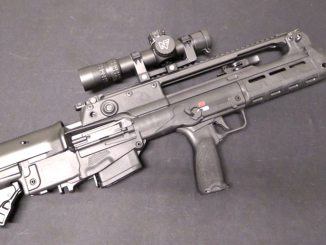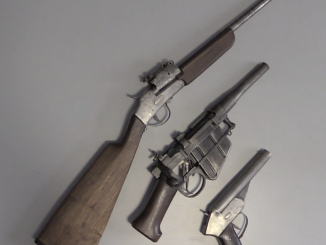The Pleter M91 is a simple design, but a high-quality one that was manufactured by a proper factory production line. The company making it was planning on (hoping for?) large-scale production, and they invested to proper polymer molds and other tools to make the gun. A total of about 4500 were made, making it the most-produced of the many Croatian domestic submachine guns.
Mechanically, the gun is most closely related to the Sten – which is clear when one sees the bolt. The magazine chosen was the Uzi magazine, and these were all chambered for 9mm. A small number were made with vented barrels and suppressors, but I don’t have one of those to show you.
A big thanks to the Croatian Police Museum (Muzej Policije) in Zagreb for giving me access to film this rare piece for you! Check them out at: https://muzej-policije.gov.hr




It uses 1:1 copy of Uzi magazine (newer type), not modified in any way!
Its kinda shameful that museum does not have a magazine, not that its impossible item to find anywhere, especially the guns being fielded by army (and maybe police probably).
There was an AR-9 magazine adapter that also used unmodified Uzi magazines, allowing you to convert your AR-15 into a 9x19mm w/ this odd welded steel foregrip sticking out of the magwell. Sadly, it’s out of production.
http://www.securityarms.com/20010315/galleryfiles/3000/3048.htm claims that
A two position feed magazine of Uzi design was typically incorporated into the Pleter submachine gun of 25 and 32 round capacity. A large number of variants existed that interfaced the Swedish Carl Gustav M45 36 round magazines and 72 round Soumi submachine gun drum magazines. This was engineered into the system to utilize the existing magazines available. In reality, this was a gun for all magazines that the country had on hand at the time.
But it was really so? Do they have stockpile of said magazines, especially older SUOMI 72 round drums?
securityarms is a shitty website with a lot of copy pasted dubious information.
However it is at least partially true (described in Soldier of fortune article) that when Pleter was in prototype stage in summer of 1991. they made variants that were fed with different magazines, probably obtained in surplus stores freely on western europe markets. The guy Ian mentioned in the video, talked in article recently (few years ago) how they smuggled carload of magazines across the border as pretense of humanitarian aid – and NOT machines, Ian confused something.
But ofc the serial production model from 1992. used uzi magazines, to be correct, their domestically made copy of it, as importation from aboard was not possible in numbers for serial production.
Theoretically they could buy from Germany mp2 magazines, but its obvious they did not want to sell – they sent absolutely no military aid, yet being loaded from surplus cold war stuff.
I dont think its impossible to replicate something like that again, much better then cutting new extra holes on magazines, though you get a stickout, true.
“(…)small number were made with vented barrels and suppressors, but I don’t have one of those to show you(…)”
Photo of Prigušen which is suppressed derivative of Pleter 91 can be seen at https://en.wikipedia.org/wiki/File:Oru%C5%BEje_vukovarska_vojarna.JPG
in upper right quarter. It is to my understanding museum exhibit called Oružje vukovarska vojarna though I am unable to detect which museum is it.
Stock used is visually similar to one found in Vigneron M2 https://modernfirearms.net/en/submachine-guns/belgium-submachine-guns/vigneron-m2-eng/ which make me wonder if they have one as sample during designing or it is total coincidence?
Oružje vukovarska vojarna means: firearms Vukovar Barracks, its just name of a photo file, they have a small museum there, in former JNA army barracks, that were during the war controlled by JNA and a constant thorn in the side of defenders. Afterwards from 1998. Croat. army used these barracks.
Nobody had a Vigneron, its visual similarity.
On the subject of these SMGs getting into the hands of organized crime syndicates …. I never understood who financed the civil wars in the former Yugoslavia, until I read the book “Whistleblower” written by a female American police officer who served in the former Yugoslavia under a United Nations contract. She described how Serbian, etc. criminal gangs smuggled drugs, sex slaves, etc. across lines. Some times these criminal gangs even used U.N. labelled ambulances. These sex slaves were being smuggled from then USSR into Western Europe, North America, etc. Meanwhile marijuana, hashish, opium, etc. were being smuggled from Afghanistan into Western Europe.
Ho hum!
Just a continuation of the thousand-year-old tradition of luxury goods following the old Silk Roads.
In Serbia in the 90s, criminal groups and clans exploded, because that was quickest ticket to wealth (and for majority of them, early death, men in their 20s). However, I wouldnt stretch them to be so powerful as to rule the whole country or directly finance the majority of war.
As for the “sex slaves”, in the 90s many eastern europe women , like from Ukraine and such, voluntarily went to the west for prostitution, as they were unemployed in their home countries (some of them having even college degrees like from Law, Medicine etc.), so sometimes its not that everbody is a victim.
Even today, in Germany and other parts of EU, there are legal brothels in every town that are filled with eastern european women, who do not have a pimp, and certainly are not a member of any criminal organisation.